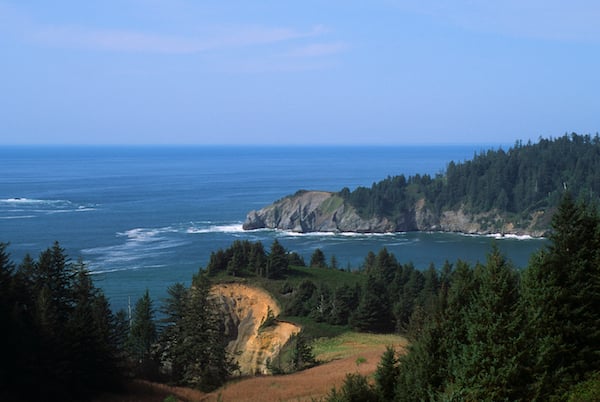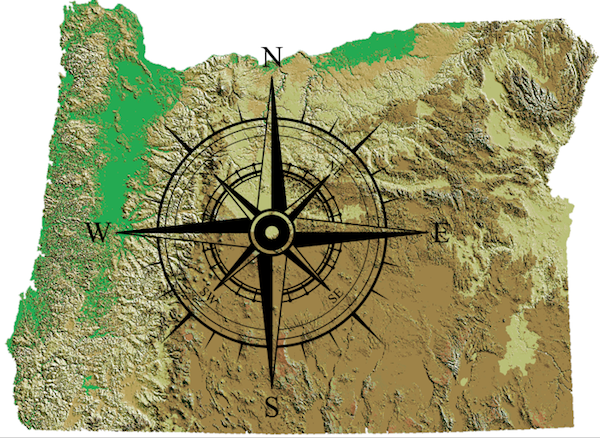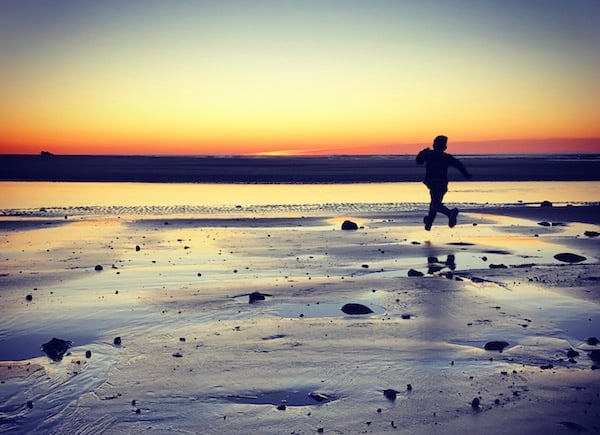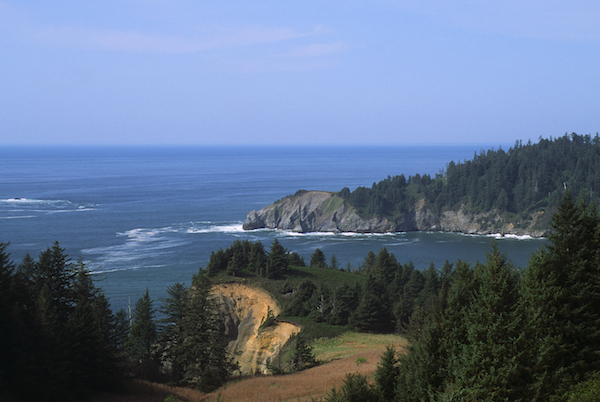
A few months back, I wrote about short piece as a peak at what my job was like as Surfrider Foundation's Oreogn Policy Manager. I thought little of the piece but was amazed at the response it generated from many folks within our membership and broader network. Given the piece focused on some of the more personal reflections on a day at work, I heard from many an interest to simply better understand the general ocean and beach policy landscape which Surfrider operates within in Oregon. So here's a quick rundown, and a little history, on the state policy framework with which we advocate to implement our mission, the protection and enjoyment of oceans, waves and beaches through a powerful activist network.
A disclaimer: This piece is limited to the statewide context of ocean and beach policy, but doesn't touch on the myriad of local and federal policies in which we operate...that's a longer, more complicated story. Here I simply touch on the primary tenets of Oregon coastal policy that intersects with our work. The Beach Bill and the Statewide Planning Goals are the easiest to grasp and most fundamental in Oregon's policy framework, while with the latter portion of ocean planning becomes a bit more convoluted - reader beware.
Oregon's Beach Bill
In 1967, Oregon's historic Governor Tom McCall, ushered through critical legislation to ensure public access and ownership of the dry sandy beaches. The Beach Bill represents a core value of Oregonians "beach birthright" and is fundamental to Surfrider's mission and core work for beach access and protection. It directs that the ocean shore be managed as a state recreational area and as such, Oregon Parks and Recreation Department (OPRD) is charged with the protection and preservation of this birthright. The OPRD accomplishes this through administrative rules, a heavy area for our advocacy - learn more about those polices and rules here. For an excellent video primer on the beach bill and it's history, check out Oregon Public Broadcasting's Beach Bill documentary here.
Our Compass: Oregon's Statewide Planning Goals
Later in 1973, McCall also set forth the interest for statewide planning goals, warning legislators through a famous speech of "sagebrush subdivisions, coastal condomania and the ravenous rampages of suburbia." The Land Use Planning Act, was passed that year establishing 19 fundamental goals that today still guide nearly every natural resource agency's management decisions. While balanced and somewhat aspirational, they set forth the state's policies for land/ocean uses as well as related topics with respect to citizen engagement and natural resources. Much of the reason Oregon looks the way it does today is because of these critical guiding principles of planning that remain fundamental in Surfrider's coastal preservation work.
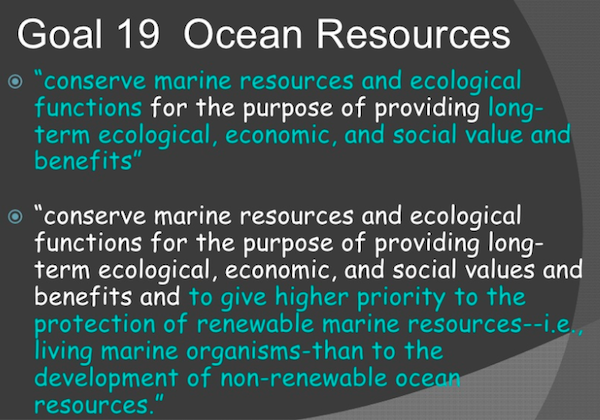 Goal 19 is a critical tool for Surfrider in fighting oil, gas and other non-renewable developments off our coast, granting higher priority of renewable over non-renewable resource development.
Goal 19 is a critical tool for Surfrider in fighting oil, gas and other non-renewable developments off our coast, granting higher priority of renewable over non-renewable resource development.
For Surfrider Foundation, Goal 1 which requires citizen involvement is fundamental to our grassroots advocacy model. Goals 16-19 are the other goals critical to the policy framework of Surfrider's mission in Oregon and they carry the same weight as an administrative rule. They guide the state's policies for managing estuaries (16), coastal shorelands (17), beaches and dunes (18), and ocean resources (19). While these goals touch many agencies' policy framework of rules and activities, The Department of Land Conservation and Development is the primary agency responsible for adopting rules through their commission for interpreting these goals. They do so through their Coastal Zone Management Program, quilting together the policies, rules and activities that relate to these planning goals. This program is critical in our state's federal compliance with the Coastal Zone Management Act providing for and balancing state and federal jurisdiction for coastal resource management. Check out this great citizens guide to the program, a fantastic regulatory roadmap!
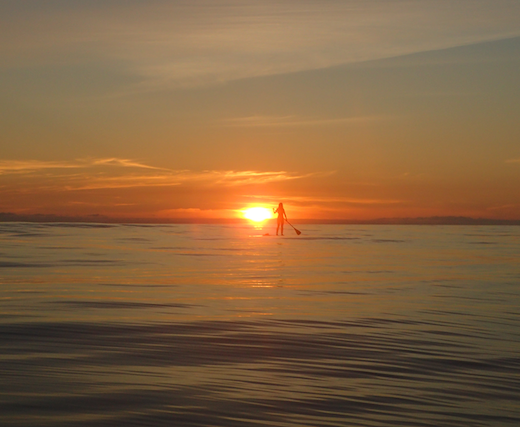 While many policies manage Oregon's recreational use of our beaches, there are much fewer policies for ocean recreational activities such as surfing, swimming and paddle sports.
While many policies manage Oregon's recreational use of our beaches, there are much fewer policies for ocean recreational activities such as surfing, swimming and paddle sports.
Oregon's Ocean Resources Management Plan
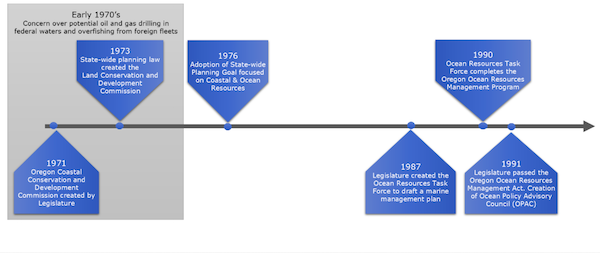 Concern for oil and gas drilling and overfishing by foreign fleets in the 70s were the primary drivers for Oregon's original ocean planning.- Photo/Timeline - Oregonocean.info
Concern for oil and gas drilling and overfishing by foreign fleets in the 70s were the primary drivers for Oregon's original ocean planning.- Photo/Timeline - Oregonocean.info
Going a little further down the road into Oregon's ocean planning two primary driving forces, foreign fleet over-fishing and aggressive Reagan-era oil drilling interest, put Oregon legislators in a hot mess to further ocean planning and protect the state's interest in our ocean. Recognizing the state's own ocean interests in tourism, recreation and local commercial fishing, and the threats of oil drilling, mineral exploration and foreign fishing fleets posed, Oregon initiated an Ocean Resources Task Force to develop an Ocean Resources Management Plan. Generally referred to as Oregon's Ocean Plan, it asserts the state's primary interests in the ocean and prepares the state for prioritized planning of new and arising ocean interests. Implemented by the Ocean Resources Management Program, it's a policy framework which prioritizes Oregon's interests around Statewide Planning Goal 19 (I told you those were important:)). There are 4 fundamental parts to the Program:
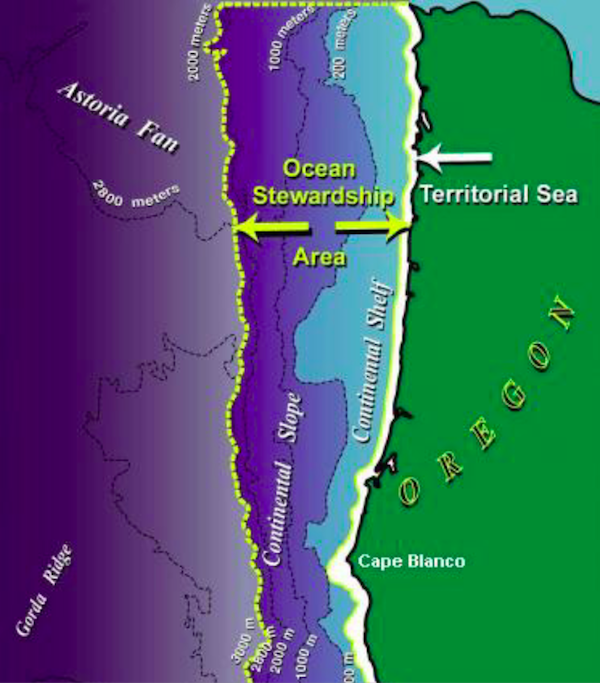 Oregon's interests go well beyond state waters at 3 miles, thus the legislature helped establish the
Ocean Stewardship Area through our Ocean Plan that extends out to the edge of the continental shelf.
Oregon's interests go well beyond state waters at 3 miles, thus the legislature helped establish the
Ocean Stewardship Area through our Ocean Plan that extends out to the edge of the continental shelf.
- The Ocean Policy Advisory Council - A Governor-appointed body that advises on ocean policy and planning efforts. The council is made up of state and federal agencies and stakeholders such as commercial and recreational fishing, conservation and non-fishing recreation (Surfrider serves on this council in the latter recreation seat)
- Territorial Sea Plan - A critical element of the state's Coastal Zone Management Plan, the Territorial Sea Plan guides policies and management within a 3-mile zone of Oregon's Ocean known as the "territorial" sea. This 3-mile zone is an area where Oregon, for the most part, has exclusive jurisdiction, while further offshore is considered federal jurisdiction.
- The Ocean Plan and Programmatic Authority - The actual aforementioned Ocean Resources Management Plan is a fundamental piece of the program, identifying ocean resource management issues and recommending policies to address those. Another critical element is the provision of authority, clearly establishing the Department of Land Conservation and Development and it's Commission with the authority and requirement to maintain consistency with the statewide planning goals (Again, I told you those were important:)).
- Geographic Location Description (GLD) - A more nuanced and recent element of the program, the "GLD" is an area within federal waters (beyond Oregon's 3 mile jurisdiction described above) where federally permitted activities (think oil/gas, aquaculture, wind energy) could have reasonably foreseeable effects on a state's coastal uses or resources. In short, it allows the state of Oregon some level of greater standing in the event that offshore permitted activities conflict with the state's interests.
If you're still awake after all of this, congratulations...I fell asleep 3 times just writing this. In addition to the hyperlinks above, I highly encourage some of the following resources for understanding and engaging in Oregon coastal policy, or just better understanding our coast. These are my top 3 clearing houses for info.
Top Oregon Ocean Policy Resources
Oregon Ocean Information - This is one stop shopping for all ocean policy in Oregon. Other than beach policy, pretty much everything covered in this blog is covered more completely and better on this webpage. Learn about upcoming meetings, current ocean issues, legislative and agency activities all in one place. It's also super user friendly and not your average boxy, text-filled agency webpage, explore rocky shores through interactive mapping, get the latest conditions through the ocean observations tools.
West Coast Ocean Partnership - Our ocean resources, habitats, ecology and culture are not restricted by the same state and federal lines of jurisdiction, thus west coast wide partnerships are one way Oregon has teamed up with our neighboring states to coordinate ocean science, and inform management and policy efforts. Previously known as the West Coast Governor's Alliance, the Partnership is a state, tribal and federal forum for fostering dialogue on ocean health and houses some useful products such as the West Coast Ocean Data Portal.
Oregon Coastal Atlas - A very public friendly resource and clearing house that provides background information on Oregon's coastal resources, habitats and uses and houses popular tools such as NANOOS, Oregon Explorer, Coastal Access Inventory, Marine Traffic, Beach Water Quality Monitoring and much more. An excellent resource for many of your basic coastal management and natural resource questions and exploring interactive mapping tools.

